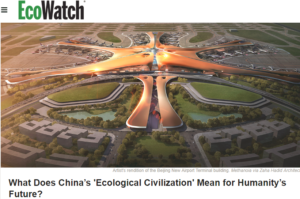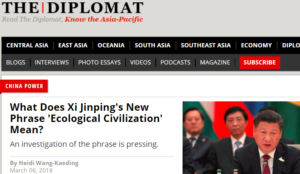Blog one of four on splitting the land of Tibet from the Tibetans as a people
China’s frequently repeated Marxist dialectic proposition, that there is a contradiction between grass and animals simply means what is obvious: the more grass the animals graze, the less grass is left, until the next growing season; conversely, the fewer the grazing animals, the more grass there is.
On that simple observation an entire ideological edifice rests, of Chinese superiority and Tibetan inferiority, culminating in China’s new era mission to construct ecological civilisation. What makes this a contradiction, a serious problem requiring decisive intervention by the sovereign nation-state to govern the grasslands? Why does this lead to the official policy of tuimu huancao, close pastures to grow more grass, in effect for the past 15 years?
Not only in Tibet, but in rangeland livestock production landscapes worldwide, mobile pastoralists have managed this contradiction simply by moving on, taking their herd to the next pasture, lifting grazing pressure well before the grass plants are grazed to the point where they cannot recover. In Tibet, where the hardy grasses and sedges of the grasslands keep most of their biomass underground, as protection not only from grazing but also from fierce gales, hail and snowstorms, it takes a lot to kill the living biomass. The grasses and the grazers have evolved together.
China has never understood or appreciated this, nor bothered to ask Tibetan drogpa nomads to explain. China has steadily moved in the opposite direction, of seeing the grazing animal herds and their herders as illiterate, ignorant, careless, destructive, to blame for degradation of the grasslands.
It is not only the centralised state that sees all nomadic land use as inherently problematic, so too do most Chinese scientists who do research on the grasslands. In a public sphere where only those who agree with the state have a voice, this sets up a circle of reinforcing rationales, a self-fulfilling dynamic, in which the scientists follow the mass line of the centre, and the centre justifies its animus against wandering nomads by citing scientific findings.
In this closed loop, it is worth taking a closer look at what China’s scientists now say about Tibet, starting with what has become, in China, a naturalised, self-evident truth. All human activity anywhere in Tibet –from urban infrastructure construction to mobile rural herding of ruminants- is now defined as a loss of what Tibet is defined by, the provision of environmental services to lowland China. All human activity is a threat, a danger. So purist is this opposition of ecology and society, so absolute are its categories, so mutually exclusive are its realms of life, anything human is immediately problematic. This is the science of ecology taken to extremes, a vision of unspoiled pristine wilderness so pure no human hand has compromised it. The assumption that all human action is a degradation was long implicit in Chinese research reports on Tibet, now it is explicit.
For the party-state, this intolerance for all human use of landscape, even the most skilfully sustainable, is a major opportunity. This new imaginary, making not only Tibet but other rangelands into virgin grassland wildernesses, is opportunity for the nation-state to fully assert its sovereignty over territory, while reducing the customary land managers to irrelevance, ignominy and even amnesiac oblivion.
The separation of land from people, ingrained in ecology as a science, now gives the recentralised authoritarians command and control over the remotest plateau rangelands, without any need to win the hearts and minds of the population, or to resettle new immigrant populations in the cryosphere.
The cryosphere, the cold realm, stands now as the opposite, the ultimate Other, to the ecological civilisation construction that is the declared mission of the CCP. It is not possible to construct an ecological civilisation unless ecology and civilisation are separate, and thus need to be brought together. This entrenched dualism renews the mandate of the CCP, as the only force capable of bringing nature and culture together. This conveniently ignores the historic reality that for thousands of years nature and culture commingled, co-existed in Tibet, and were never conceived of as competing realms, one to be subjected to the other, or laboriously welded back together.
Xi Jinping, in a major speech in May 2018, says China must: “push ecological civilization to a new level ,during a tone-setting meeting on environmental protection ending Saturday. Xi said the country will channel more energy into promoting ecological civilization and resolving environmental problems, backed by the political advantages of the centralized and unified leadership of the CPC and the socialist system. Building an ecological civilization is of fundamental importance for the sustainable development of the Chinese nation, Xi said. The building of ecological civilization has entered a critical period. Xi said ecology and environment are closely connected with people’s well-being, urging works to be done to meet public expectations by stepping up the building of ecological civilization and providing more quality ecological products. Xi said China must abide by the following principles to push forward ecological civilization in a new era:
— Ensuring harmony between human and nature. China must stick to the policy of putting conservation and protection first, and mainly relying on the natural recovery of the environment.
— Lucid waters and lush mountains are invaluable assets.
— Mountains, rivers, forests, farmlands, lakes, and grasslands are a life community. The building of ecological civilization must take all factors into consideration with good overall plans and multiple measures.
“The nation must speed up the construction of the ecological civilization system, to ensure that by 2035, there will be a fundamental improvement in the quality of the environment, and the goal of building a Beautiful China will be basically attained.”
TO RULE YOU MUST DISMOUNT FROM THE CONQUEROR’S HORSE
China has found a solution to the long term problematic of turning an empire into a nation-state, not by winning the loyalty of the conquered to their alien rulers, but by removing the people from the vacated land, which is thereby renamed as biodiverse protected area. It is the party-state in charge of official protection, giving the party a role and a legitimacy it has struggled for six decades to find.
This bold move requires us to believe that the party-state cares so deeply for wildlife it is willing to forego food security, production landscape uses, mineral extraction uses and all other modes of production and revenue raising, for the sake of wildlife and water provision. Yet China has not at all abandoned its passion for economic growth, for maximal utilisation of arable land, its intensification of urbanisation, its wealth accumulation and transition to a high income economy dominated by high technology and high consumption. Nor has China abandoned its global dominance of wildlife trafficking, its destruction of migratory bird flyways by robbing shorebirds of shores, replacing them with industrial land reclamation and intensive aquaculture.
What has been abandoned, and is nowhere mentioned in Xi Jinping’s speech praising mountains, rivers, forests, farmlands, lakes, and grasslands is the people of the grasslands who, in course of daily productive life, managed to sustainably maintain those grasslands and mountains, and the wildlife, without ever separating ecology from civilisation. There now seems to be literally no place for those Tibetans once the ecological civilisation is constructed.
This is not a question of double standards or hypocrisy, but of double geography, with a double logic. The decisive diremption of China, invented by geographer Hu Huanyong in 1935, is the key. By slicing one straight line across China, from the far southwest to the northeast border with Siberia, Hu elegantly dissected China into a southeast half that only accounted for 36% of the land but housed 96% of the population while the northwest half accounted for 64% of the land area but only 4% of the population. This had to be problematic.
This imbalance seemed, to Mao’s revolutionary China, to require emigrating millions of settlers to boost the thinly populated rangelands, a strategy backed by coercion and revolutionary pioneering enthusiasm, that in Inner Mongolia, Heilongjiang and Xinjiang often succeeded, but not in Tibet. If only four per cent of the total population of overcrowded China lives beyond the arable lowlands, move the masses, plough the virgin grasslands, dam the rivers, drill the oil. This old strategy had, over a thousand years, made southern China Chinese, then Sichuan and Yunnan. What was revolutionary about the revolution was not its goal, but its speeding up of well-rehearsed methods for pushing and pulling the poor and vulnerable from landless penury in their home provinces, to resettle the frontiers.
In Tibet alone, this strategy did not work. Tibet was too high, too cold, for immigrant farmers to farm anything, to produce crops sufficient to generate a new economic dynamic, and the Tibetans were too suspicious. Unlike Inner Mongolia, there had been very few Tibetan communists, and it took a full-scale modern war, won by PLA artillery and aerial bombardment in the late 1950s, to subdue the Tibetans of Kham and Amdo.
Thereafter, central planners, in one Five-Year Plan after another, announced many new pillar industries that would launch Tibet into production of surpluses, and nearly all failed to materialise, or destroyed their resource. Productivist ideology did succeed in increasing livestock herd size, but without creating an export commodity chain comparable to what Soviet aid set up in pastoral Mongolia for Russian consumption.
Productivism reigned for four decades or more in revolutionary China with little to show for it, other than the oil, gas and mineral extraction zones of Qinghai. By the start of this century logging of the forests of eastern Tibet had to be halted because summer monsoon rains on the stripped hillslopes of Kham went straight into the upper Yangtze, causing the massive 1998 floods downriver. Productivism had run its course.
The new approach is post-industrial and post-productivist, repurposing the whole of Tibet as natural, virgin, pristine wilderness, supplying environmental services, notably water and tourism destinations, to lowland China, and the world. In many ways, this is a repositioning in keeping with China’s transition from a centrally planned command and control economy in which Tibet is at most a supplier of raw materials, producer goods of high volume but low price, shipped off for value adding by smelters and timber mills elsewhere. China as a whole is transitioning from reliance on heavy manufacturing –the world’s factory- to more high priced high tech, and a services-based economy led by consumer demand. Tibet’s role in this transition is to become a destination for mass domestic tourism, which requires it to be a pure no-man’s land, largely devoid of inhabitants, providing glimpses of thrilling wild animals, China’s own safari land.
This turns the old problematic on its head. Since Hu Huanyong in 1935 identified northern and western China as having 64 per cent of China’s territory but only four per cent of its population, the policy imperative was to find ways of making the vast northwest produce more, and house more.
A NEW SOLUTION TO THE TIBETAN PROBLEM
Now with the aid of ecology as a science of the non-human, a simpler solution beckons. Simply remove the four per cent from the land, park them in settlements of the expelled on the fringes of the new urbs, and the depopulated land immediately becomes the exclusive domain of the sovereign party-state, with no counter claim. As the pastoral production landscapes become national parks, a few of the former nomads can be retrained and employed as park rangers, displaying the magnanimity of the party-state in benevolently lifting the destitute out of poverty.
Removing the four per cent is far easier than doubling the plateau population. The entire Tibetan population of six millions (2010 Census count) is only one in 200 of the total population of China, a tiny fraction to move out of the way of fulfilling a grand consumer culture narrative of access to virgin lands.
This leaves a depopulated land unequivocally in the hands of the sovereign nation-state, in ways never achieved while those lands were the pastures of mobile livestock producers and Tibetan crop farmers. The loss of food production, and of food security in Tibet, are small prices to pay for allocating Tibet its part in the great rejuvenation of new era China’s ecological civilisation. Modern managerialism means the surplus Tibetans need not be removed too far, many staying on the land, trained and employed as national park ranger staff, to enforce livestock exclusions, greet the tourist masses, dress colourfully, dance and pose with visitors alongside yaks and mastiffs. Thus China achieves multiple goals the world yearns for: carbon capture, enhanced water supply, poverty alleviation, protection of wildlife, education in new vocational skills for illiterate herders, and education in individual tastes for the tourist masses learning to become individual consumers. That’s a six-fold win.
A further benefit, for a centralised authoritarian system is that authority is concentrated in the gaze of the state, while the aspirations, experience and values of the pastoralists fade from view. In order to ascertain the human footprint in Tibet, remote sensing satellites can do it all. Geoinformatics readily turns satellite sourced data into maps, resulting in visible, mapped, objective truth fit for policy makers.



